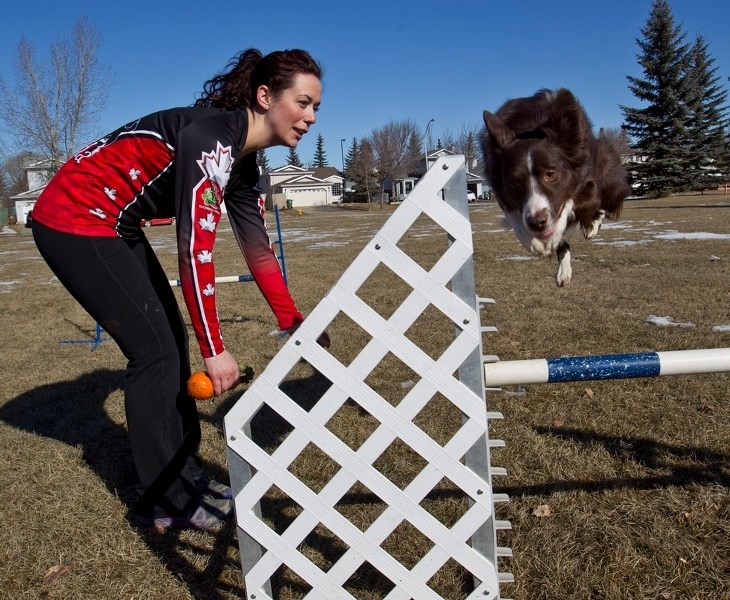Doggy be nimble. Doggy be quick. Doggy jumps over the candlestick.
Today three-year-old Shine and five-year-old Rush are training at a St. Albert park. A weak sun shines over brown grass covered in snow and a northerly wind chills the air. Even as the humans shiver, two purebred border collies are squirming with energy.
St. Albert handler Rebecca McKay starts the one-hour session with play. She produces a tug rope with a ball on the end that acts as a bungee toy. As McKay swings the toy from side-to-side, the two collies focus on grabbing it, every muscle tensed for a quick snatch.
From a distance, the three look like they’re enjoying a leisurely fun day. In fact, Shine and Rush are Canadian agility champions that have competed on the international level.
This year, the three-year-old lightning-quick Shine is once again on the Canadian team for the IFCS World Agility Championships unfolding April 7 to 12 in Italy. Five-year-old Rush is an alternate.
“Shine is fearless, fast and focused. She is an incredible worker, and really challenges Rebecca to push her handling and thinking so that she can keep Shine directed through challenging sequences. They have a great connection on course, and really read each other well,” says Seanna O’Neill, Canada team manager.
Last year, the fleet-footed Shine ran fourth overall. This year McKay has high hopes the turbo-charged pooch will earn more points on the obstacle run as she clears hurdles, snakes through weave poles, sprints across planks, zooms into tunnels and scales A-frames.
Only the speediest competitors that cleanly navigate obstacles progress to world competitions. They are the ultimate test of a dog’s speed and prowess, the handler’s skill and the rapport between the two.
“As she gets older, she’s more experienced and we’re getting better as a team,” says McKay, a resident assessment instructor Youville Home.
“When she came in fourth last year I didn’t expect that. I hoped we’d have a good experience. She ran two clean rounds and was very fast, but we’ve made some improvements since then.”
“We’ve worked on her turning. She was running wilder last year and now she’s running tighter and being more efficient.”
Not only has McKay worked with Shine, but she’s also upped her own game.
“I’ve gotten myself faster. That’s what held us back last year. Some of those European handlers are ex-soccer players and they are so fast and you have to be able to compete against them.”
Born in Edmonton and raised in St. Albert, McKay is a graduate of St. Albert Catholic High School and of the registered nursing program at Grant MacEwan College.
Growing up in the community, McKay was a hardcore competitor in swimming, cycling and triathlons. She was introduced to Kids of Steel at age five and as a teen gravitated to the Canadian Junior Triathlon Championships and Canadian Junior Biathlon Championships.
But at 17, the highly competitive athlete suffered a severe back injury moving boxes at a warehouse.
“I couldn’t run on snow or even packed dirt. I didn’t get paid and because of that I didn’t get the treatment I needed. It took one and one-half years to heal, but because I have scoliosis, I made sure I was in good shape. Now I have no limitations.”
Her strong competitive streak and a love of dogs attracted her to agility. Her first dog was Sadie.
“She wasn’t as motivated as my current dogs, but when I started training I got hooked and my commitment has grown.”
More than anything, McKay enjoys the variety and the inter-species dynamic.
“Every time you run a course, it’s never the same. And I like the relationship with a dog, the communication you build. It’s a form of play for them while you’re going through a different challenge.”
Normally McKay trains her four-footed partners at a barn in Sturgeon County. But today, she’s opted for fresh air in a park.
Photographer Chris Colbourne frames his lens for Shine’s impressive leaps. She explodes and shoots over a hurdle.
He checks the missed digital image and growls, “Ahhh. She’s faster than my camera.”
McKay estimates Shine posts about six or seven yards per second on a straight course.
“Local courses are easier because they are straight. International courses are more complex because they have twists and turns. It becomes a challenge for the handler to remember the course and the dog to navigate it.”
However, speed isn’t everything. Rush once slammed into another competitor and hurt his back. Although both are border collies, Rush and Shine have a different approach to competition.
“Rush is a little bit bigger and moves differently than Shine. His moves are thoughtful. She just does it. He moves more carefully and doesn’t make mistakes. And his colour – I love it – a deep chocolate. He’s always watchful, no matter what he does. Instead she’s quite forceful.”
Since these two wet-nosed athletes need to be in top tier shape, McKay feeds them premium dog food, and provides visits to a chiropractor and masseuse for tune-ups.
“The dogs go once a month. I don’t go nearly as much, but I don’t work nearly as hard. It’s more about preventing injuries and finding trouble spots before they become injuries.”
Shine has earned her place on the world stage. Win or lose, she’ll share the day with her favourite human and ultimately that’s what counts.




